Mnamon
Ancient writing systems in the Mediterranean
A critical guide to electronic resources
News
-
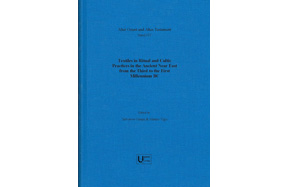 2019-10-29
2019-10-29Book
S. Gaspa, M. Vigo (eds.), Textiles in Ritual and Cultic Practices in the Ancient Near East from the Third to the First Millennium BC (Alter Orient und Altes Testament 431), Münster: Ugarit-Verlag 2019, VIII+268 pp., ISBN 978-3-86835-187-3.
The anthology is the outcome of a research project leaded by Salvatore Gaspa and funded by the Carlsberg Foundation (Denmark). It mostly includes papers presented at an international conference organized by Salvatore Gaspa (University of Padua) and Matteo Vigo (Akademie der Wissenschaften und der Literatur Mainz, Hethitologie-Archiv) at the Saxo Institute, University of Copenhagen in 2015. Through the analysis of textual and visual art evidence from various regions of the ancient Near East (Egypt, Mesopotamia, Syria, Anatolia, Iran) from the 3rd to the 1st millennium BCE different international scholars offer for the first time an in-depth investigation of the use of textiles in various types of ritual practices and the symbolic meaning attached to these products. Numerous texts witness to the ritual use of textiles or textile-related tools in the Near East, from the Ebla texts of the 3rd millennium BCE to the Hittite texts of the 2nd millennium to the Assyrian and Babylonian written evidence of the 1st millennium BCE. Thus, the book represents a collective multidisciplinary effort to combine the current historical research on ancient Near Eastern epigraphical, linguistic and material evidence with textile-related analysis and recent trends in ritual studies. -
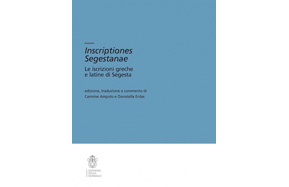 2019-09-13
2019-09-13Book
“Inscriptiones Segestanae. Le iscrizioni greche e latine di Segesta”, edizione, traduzione e commento di C. Ampolo e D. Erdas, Edizioni della Normale, Pisa, 2019.
The volume offers the critical edition of the Greek and Latin inscriptions of ancient Segesta, in their historical and archaeological context, with a commentary, a translation, images and plates. It includes 54 already known and new inscriptions and an appendix of 6 epigraphic texts concerning Segesta and its history. Many among them resulted from the excavations of the Scuola Normale in the Segestan agora, and they are part of the SAET project on historical and epigraphic studies in Sicily. The entire corpus allows us to approach in a new manner the Hellenistic and Roman polis, its history, institutions, town planning and, above all, the ancient Segestans, also offering a contribution to the knowledge of ancient Sicily and beyond. -
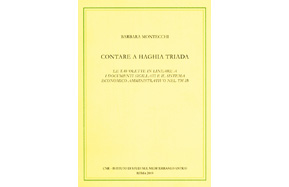 2019-07-24
2019-07-24Book
B. Montecchi, Contare a Haghia Triada. Le tavolette in lineare A, i documenti sigillati e il sistema economico-amministrativo nel TM IB, Roma, CNR Edizioni, 2019 (Incunabula Graeca, CVII), X+434 pp., ISBN 978-88-8080-349-2.
The volume, which has been published with the generous financial support of the Institute for Aegean Prehistory (INSTAP), Philadelphia, offers the first comprehensive study of the Linear A archival documents from the Cretan site of Hagia Triada. The 147 clay tablets and the more than 1,000 sealings found in the excavation at the beginning of the last century and dating approximately to the 15th century BC still constitute the largest assemblage of archival documents of the Neopalatial period and represent the fundamental starting point for any attempt of interpretation of the Minoan economy. Through a careful analysis of their textual, palaeographic and sphragistic features, as well as their respective archaeological contexts and patterns of distribution, the author tries to reconstruct the contents and functions of the individual archival deposits found both in the Villa and the rest of the settlement. A special attention in this process is paid to the roles and status of the people involved in sealing and writing practices, in an attempt to understand how much the individuals responsible for accounting also “counted” in an economic, political and social sense. Finally, the results of this analysis are compared with the Messara archaeological data, in order to draw an updated picture of the settlement dynamics in the region, with a special attention to the relationship between Hagia Triada and the Phaistos palace. -
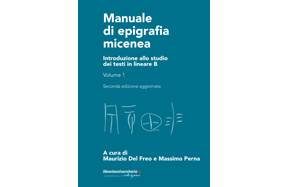 2019-07-24
2019-07-24Book
Manuale di epigrafia micenea. Introduzione allo studio dei testi in lineare B, Seconda edizione aggiornata, a cura di Maurizio Del Freo e Massimo Perna, 2 voll., Padova, libreriauniversitaria.it edizioni, 2019, ISBN 978-88-3359-164-3.
The handbook, which is the fruit of the collaboration of a group of specialists from various universities and research centres in Italy and abroad, aims to provide an updated overview about Mycenaean epigraphy. It contains an introduction to the writing and language of the Mycenaean texts and a detailed analysis of the main Linear B documents divided by topic. In the first volume the Linear B writing system and the Mycenaean scribal and administrative practices are analyzed and compared with their Minoan antecedents (Cretan Hieroglyphics and Linear A). The second volume contains a detailed description of the different production sectors as they can be reconstructed from the Linear B texts as well as a synthesis of some major topics relating to the Mycenaean world, such as geography, society, economy and religion. Each chapter is provided with an essential bibliography. The book ends with a glossary of the Mycenaean words.
The second edition of the handbook contains bibliographic updates and comments both on new inscriptions and the most significant epigraphic, philological and paleographic contributions appeared after 2016. -
 2019-03-18
2019-03-18Mnamon Seminars
On April 16th starting at 11,30 a.m. in Scuola Normale Superiore, Sala Azzurra conference room, Palazzo della Carovana, the following seminar will be held:
Anna Cannavò (HISOMA CNRS)
“L’eteocipriota: stato dell’arte e novità recenti”.
Diretta video streaming sul canale YouTube SNS
(A.Russo) -
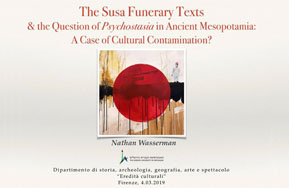 2019-03-02
2019-03-02Seminar
On March 4th, the seminar “The Susa funerary texts & the question of psychostasia in Ancient Mesopotamia: a case of cultural contamination?” will be held by Nathan Wasserman (The Hebrew University of Jerusalem) at 3 p.m. at the Dipartimento di Storia, Archeologia, Geografia, Arte e Spettacolo, Aula Magna, Palazzo Fenzi, Via San Gallo in Florence.
-
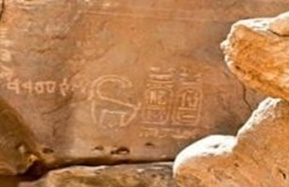 2019-02-20
2019-02-20Royal signature of King Ramses III
Saudi Arabian archaeologists discovered a hieroglyphic inscription illustrating the signature of King Ramses III, one of the kings of Pharaonic Egypt. The Hieroglyphic inscription was found on a fixed rock, near the Tayma oasis. It bears a royal signature (a double cartouche) of King Ramses III.
https://www.egypttoday.com/Article/4/63386/Hieroglyphic-inscriptions-discovered-in-Saudi-Arabia
(D.Salvoldi)
-
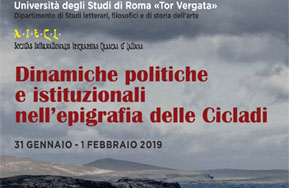 2019-01-23
2019-01-23Workshop
The workshop "Epigrammata 5. Dinamiche politiche e istituzionali nell'epigrafia delle Cicladi" will take place in Rome, Università di Roma Tor Vergata, "Roberto Pretagostini" conference room, from January 31st to February 1th 2019.
Program available here.
